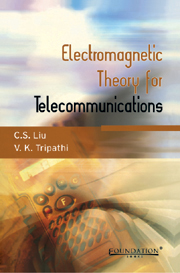Book contents
- Frontmatter
- Contents
- Preface
- 1 Electromagnetic Fields
- 2 Plane Waves
- 3 Guided Waves
- 4 Radiation
- 5 Radio Communication and Radar
- 6 Satellite Communication
- 7 Laser and Optical Fibre Communication
- 8 Geological Seisming and Remote Sensing
- 9 Relativistic Covariance of Electrodynamics
- 10 Radiation from Accelerated Charges
- Appendix A
- Appendix B
- Index
7 - Laser and Optical Fibre Communication
Published online by Cambridge University Press: 26 October 2011
- Frontmatter
- Contents
- Preface
- 1 Electromagnetic Fields
- 2 Plane Waves
- 3 Guided Waves
- 4 Radiation
- 5 Radio Communication and Radar
- 6 Satellite Communication
- 7 Laser and Optical Fibre Communication
- 8 Geological Seisming and Remote Sensing
- 9 Relativistic Covariance of Electrodynamics
- 10 Radiation from Accelerated Charges
- Appendix A
- Appendix B
- Index
Summary
Introduction
With the advent of semiconductor laser and low-loss (≤ 0.2 db/km) optical fibre, optical communication has emerged as the fastest mode of information transmission at short, long and transoceanic distances. It employs infrared/ visible frequencies (≥100 THz) which, within a bandwidth of 1%, can (in principle) transmit data at the rate of 1012 bits (pulses) per second or lTb/s. A major constraint on bit transmission rate, B, comes from the dispersion broadening and attenuation of the pulsed signals in optical fibres. With the employment of erbium-doped fibre amplifier repeaters, placed at every 60 to 100 km, one can overcome this limitation considerably. Consequently, a 27,300 km fibre optic link around the globe (called FLAG) at a bit rate of 5 Gb/s became commercially operational in 1997. Since then, transoceanic links operating at lOOGb/s have been set up. In this chapter, we will study the basic principles of lasers, with special emphasis on semiconductor laser and wave propogation through step-index and graded-index fibres.
Laser
Atomic transitions from higher energy states to lower energy states are a common source of radiation. An analytical theory of this process is a subject of quantum electrodynamics and is beyond the scope of this book. However, we shall discuss a very special class of such light sources, called lasers, using quantum theory of radiation. Laser is the acronym of Light Amplification via Stimulated Emission of Radiation.
Atom in any material tends to stay in a state, where total energy of all its orbiting electrons is minimum in accordance with Pauli's exclusion principle.
- Type
- Chapter
- Information
- Electromagnetic Theory for Telecommunications , pp. 208 - 243Publisher: Foundation BooksPrint publication year: 2007

